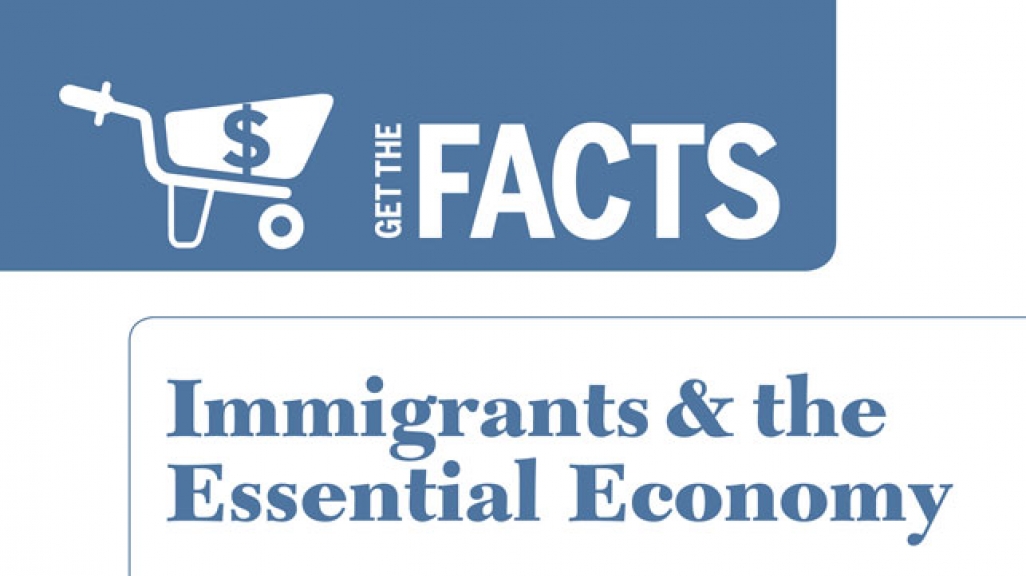Get the Facts: Five Ways Immigrants Drive the Essential Economy
Get the Facts: Five Ways Immigrants Drive the Essential Economy
U.S. industries that fuel the economy—such as food services, construction, and agriculture—rely heavily on immigrants.
The essential economy—which encompasses the food services and hospitality industries, construction, agriculture, elder care, and manufacturing—is fundamental to the U.S. economy and society as a whole.[1] Immigrants’ participation in these sectors creates new jobs for native-born workers, contributes to the growth of construction and agriculture, and provides essential care to the United States’ aging population. This fact sheet—the tenth in our series on immigrants and the economy—details five reasons why immigrants are vital to the success of the essential economy.
- Download a PDF of the fact sheet.
- Access AS/COA’s Get the Facts series at: www.as-coa.org/immigration-facts.
1. Immigrants play a critical role in supporting the food service and hospitality industries by meeting labor market demand and creating jobs as small-business owners.
- Despite accounting for 13 percent of the U.S. population, immigrants represent 22 percent of workers (1.8 million people) in the food service industry.[2] In addition, in 2010, 37 percent of all restaurant small-business owners were foreign-born, accounting for nearly 77,000 restaurants across the country.[3]
- After Georgia’s State Legislature passed the restrictive HB 87 immigration law in April 2011, a survey conducted in November of that year by the Georgia Restaurant Association found that 71 percent[4] of restaurant owners were experiencing a labor shortage, up from 49 percent five months earlier.[5]
- As of 2010, 31 percent of the workforce in the hotel and lodging industry were foreign-born[6] and 43 percent of owners of small hotels and motels were immigrants.[7] By 2020, the hotel industry is projected to see an increase in 141,000 jobs, many of which will be created and filled by immigrants.[8]
2. Immigrants are supporting growth of the construction industry—a key measure of how well the economy is bouncing back from the Great Recession.
- Construction is one of the fastest-growing industries in the country, and is expected to create 1.8 million additional jobs by 2020.[9] As of 2011, immigrants represented 22 percent of this essential labor force.[10]
- Immigrants also help spur the demand for housing. If net immigration between 2010 and 2020 is 1.2 million people—the low end projection from the 2010 Census—at the end of this decade new immigrants would account for 900,000 homeowners nationwide.[11]
- North Carolina has two of the top 20 fastest-growing housing markets in the nation (Charlotte and Raleigh/Durham),[12] and in the state 23 percent of the construction industry’s labor force is foreign-born.[13] The boom has led to a 4.2 percent increase in economic output in the construction sector this year[14]—a reversal of the -4.0 percent average output nationwide between 2002 and 2012.[15]
3. With demand for produce at an all-time high, agriculture workers—nearly three-fourths of whom are foreign-born—are essential to getting food from our farms to our supermarkets.[16]
- U.S. consumption of fruits and vegetables rose 10.5 percent from the period of 1998-2000 to 2008-2012, but as a result of a rise in restrictive immigration laws, the amount of imported produce rose by 73.9 percent during the same time period. Had U.S. producers been able to fill the vacancies to produce the fruits and vegetables domestically, GDP would have increased by an additional $12.4 billion in 2012.[17]
- In California, only 233 U.S. residents and native-born citizens applied to 1,160 farm job listings in 2010, resulting in labor shortages and production cutbacks. As one example, land devoted to garlic production in the state dropped from 41,000 acres in 1999 to 25,000 acres in 2012, in part due to a lack of labor.[18]
- For every three to five H-2A visas granted to farm workers in North Carolina in 2012, one job was created and filled by a native-born worker, and at least $248 million was added to the economy.[19]
4. With a rapidly aging U.S. population, immigrants help to meet the increasing demand for in-home health aids and assisted living for seniors.
- With the elderly population (65 and older) expected to more than double by 2040,[20] it is projected that the demand for personal care and home health aides will grow by 46 and 50 percent, respectively, between 2008 and 2018. But women aged 20 to 50—the demographic that traditionally fills these jobs—will only increase by 9 percent between 2000 and 2030.[21] Immigrants, who are currently 28 percent of home health aides, [22] are projected to make up 23 percent of the working age population by 2050[23] and will be key to filling this gap.
- Immigrants make up 42 percent of the direct care and personal assistance workforce in Florida,[24] which has one of the oldest populations in the nation with a median age of 40.4 (compared to 37.6 nationwide)[25] and a total of 1.4 million residents in their 70s and older as of April 2009.[26]
5. Immigrants play an outsize role in the manufacturing industry, keeping middle-class jobs in the U.S. and helping to revitalize declining economies across the country.
- In Arizona, immigrants make up 46 percent of the textile-related workforce and 22 percent of metal workers. A reduction of only 10 percent in the foreign-born manufacturing workforce in that state would result in the loss of up to $100 million in tax revenue and the loss of 12,000 full-time jobs.[27]
- Though immigrants make up 7 percent of Minnesota’s population, they represent over 16.5 percent of its manufacturing workforce,[28] an industry which accounts for 15 percent of the state’s GDP and contributes $37 billion to the state economy.[29] As one example, 6,586 manufacturing jobs were created or preserved in Hennepin, MN between 1970 and 2010 due to immigration.[30]
- Between 1970 and 2010, Los Angeles County saw its immigrant population increase by 2.7 million, while Chicago and surrounding Cook County received only 600,000 immigrants. While the U.S. manufacturing industry largely moved overseas during that period, Los Angeles was able to hold onto twice as many manufacturing jobs (406,878) as Chicago (202,540).[31]
This fact sheet is a product of the AS/COA Immigration and Integration Initiative, which promotes positive dialogue around the economic contributions of immigrants across the United States. It was produced by Rebecca Bintrim and Adam Wolsky in collaboration with Kate Brick and Richard André, co-directors of the Immigration and Integration Initiative. For media inquiries or to speak with an expert on this topic, please contact Adriana La Rotta in our communications office at: alarotta@as-coa.org.
[1] The term “Essential Economy” was coined by the Essential Economy Council, which defines it as an occupational cluster that includes six sectors: hospitality and restaurants, agriculture and poultry, light construction and landscaping, personal care and assisted living, building maintenance and facilities services, and distribution and logistics.
[2] Bureau of Labor Statistics, “Employed foreign-born and native-born persons 16 years and over by occupation and sex, 2013 annual averages,” United States Department of Labor, 2013.
[3] Immigration Research Initiative, “Immigrant Small Business Owners,” Fiscal Policy Institute, 2012.
[4] “Georgia Immigration Reform: Restaurant Impact Study – November 2011,” Georgia Restaurant Association, 2011.
[5] “Georgia Immigration Reform: Restaurant Impact Study,” Georgia Restaurant Association, 2011.
[6] Audrey Singer, “Immigrant Workers in the U.S. Labor Force,” Brookings Institution, 2012.
[7] Frank Bass, "Almost 1 in 5 Small U.S. Businesses Owned By Immigrants," Bloomberg News, 2012.
[8] "Spotlight Immigration Reform," American Hotel & Lodging Association, 2014.
[9] Richard Henderson, “Industry employment and output projections to 2020,” Bureau of Labor Statistics, 2012.
[10] “Immigrant Workers in the Construction Labor Force,” National Association of Home Builders Economics, 2013.
[11] Natalia Siniavskaia, “Immigrants and Housing Demand,” National Association of Home Builders, 2012.
[12] “Emerging Trends in Real Estate 2014,” Urban Land Institute, 2014, p.41-42.
[13] “Immigrant Workers in the Construction Labor Force,” National Association of Home Builders Economics, 2013.
[14] Deon Roberts, “NC Economy to Grow in 2014, UNC Charlotte Economist Predicts,” The Charlotte Observer, 2014.
[15] “Industry employment and output projections to 2022,” Monthly Labor Review, 2013.
[16] Economic Research Service, “Immigration and the Rural Workforce,” U.S. Department of Agriculture, 2013.
[17] Stephen Bronars, “No Longer Home Grown: How Labor Shortages are Increasing America’s Reliance on Imported Fresh Produce and Slowing U.S. Economic Growth,” The Partnership for a New American Economy and the Agriculture Coalition for Immigration Reform, 2014, p.5.
[18] Ibid, p.9, 11.
[19] Michael Clemens, “International Harvest: A case Study of How Foreign Workers Help American Farms Grow Crops—and the Economy,” The Partnership for a New American Economy and the Center for Global Development, 2013, p.2.
[20] “Projected Future Growth of the Older Population,” Administration on Aging.
[21] Diana Polson, “By Our Sides: The Vital Work of Immigrant Direct Care Workers,” Direct Care Alliance Inc., 2011, p.3.
[22] Jane Henrici, “Improving Career Opportunities for Immigrant Women In-Home Care Workers,” Institute for Women’s Policy Research, 2013, p.5.
[23] Jeffrey S. Passel and D’Vera Cohn, “U.S. Population Projections: 2005-2050,” Pew Research Center Social & Demographic Trends 2008, p.13.
[24] Joe Caldwell, “Immigration Reform: Key Issues for People with Disabilities and Older Adults,” National Council on Aging, 2014, p.3.
[25] CIA World Factbook, “United States Median Age.”
[26] “Florida: Demographics,” The Florida Legislature Office of Economic and Demographic Research, 2011.
[27] Judith Gans, “Immigrants in Arizona: Fiscal and Economic Impacts,” Udall Center for Studies in Public Policy: The University of Arizona, 2008 p.4-6.
[28] Bruce P. Corrie and Sarah Radosevich, “The Economic Contributions of Immigrants in Minnesota,” 2013, p.47.
[29] “Manufacturing Fast Facts,” Minnesota Precisions Manufacturing Association.
[30] Jacob Vigdor, “Immigration and the Revival of American Cities: From Preserving Manufacturing Jobs to Strengthening the Housing Market,” Americas Society/Council of the Americas, 2013, p.27.
[31] Ibid, p.7.









